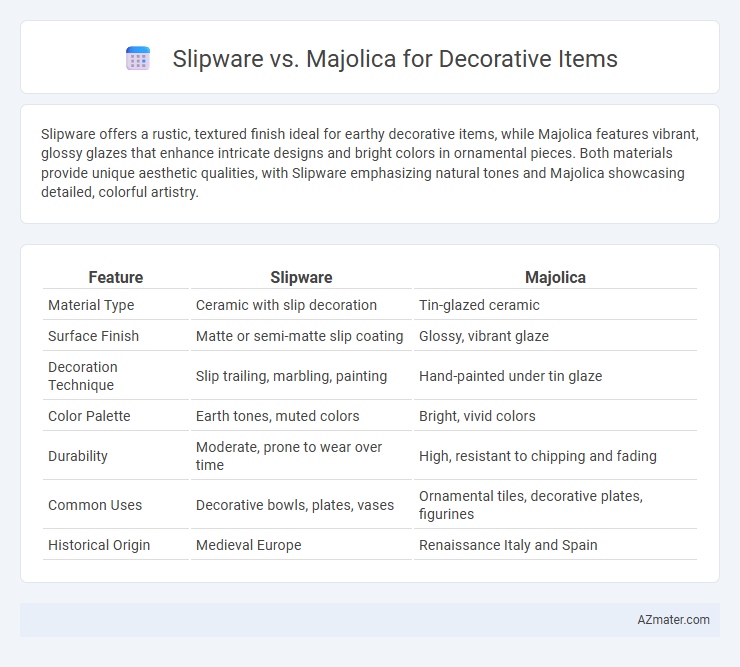Slipware offers a rustic, textured finish ideal for earthy decorative items, while Majolica features vibrant, glossy glazes that enhance intricate designs and bright colors in ornamental pieces. Both materials provide unique aesthetic qualities, with Slipware emphasizing natural tones and Majolica showcasing detailed, colorful artistry.
Table of Comparison
| Feature | Slipware | Majolica |
|---|---|---|
| Material Type | Ceramic with slip decoration | Tin-glazed ceramic |
| Surface Finish | Matte or semi-matte slip coating | Glossy, vibrant glaze |
| Decoration Technique | Slip trailing, marbling, painting | Hand-painted under tin glaze |
| Color Palette | Earth tones, muted colors | Bright, vivid colors |
| Durability | Moderate, prone to wear over time | High, resistant to chipping and fading |
| Common Uses | Decorative bowls, plates, vases | Ornamental tiles, decorative plates, figurines |
| Historical Origin | Medieval Europe | Renaissance Italy and Spain |
Introduction to Slipware and Majolica
Slipware is a type of pottery characterized by the application of liquid clay slip to create intricate surface decorations, often featuring contrasting colors and textured patterns. Majolica, also known as maiolica, is a tin-glazed pottery technique that applies a white opaque glaze onto the ceramic body, serving as a vibrant canvas for detailed, colorful painted designs. Both styles have historic roots in traditional ceramics but differ significantly in glazing methods and decorative aesthetics, making them distinct choices for decorative items.
Historical Origins and Evolution
Slipware originated in ancient pottery traditions, characterized by the application of liquid clay slip to create decorative patterns, evolving prominently during the medieval period in Europe. Majolica developed in the Renaissance era, particularly in Italy and Spain, distinguished by its tin-glazed earthenware that allowed for vibrant, colorful surfaces and intricate painted designs. Both techniques have evolved through centuries, with slipware maintaining rustic, earthy aesthetics while majolica became synonymous with ornate, glossy finishes used in decorative items.
Key Materials and Techniques
Slipware decorative items are crafted using a liquid clay mixture called slip, which is applied to the surface of pottery before firing to create intricate designs and textured finishes. Majolica employs a tin-glazed earthenware technique, where a white opaque glaze is applied and painted with vibrant mineral pigments, resulting in glossy, colorful surfaces ideal for decorative purposes. The key difference lies in slipware's emphasis on slip decoration and tactile texture, while majolica focuses on vibrant, glossy finishes achieved through tin glaze and detailed painting.
Visual Characteristics and Aesthetics
Slipware features a matte or satin finish with earthy tones and intricate sgraffito or trailing slip decorations, emphasizing texture and subtle visual depth. Majolica is known for its vibrant, glossy glaze and richly colored, often floral or figural, motifs that create a striking and luminous appearance. Both styles showcase artisanal craftsmanship but differ in sheen and color intensity, making slipware ideal for rustic aesthetics and majolica perfect for bold, decorative accents.
Functional Durability for Decorative Use
Slipware and Majolica both offer vibrant decorative finishes, but slipware generally provides superior functional durability due to its thicker, more resilient slip coating that resists chipping and cracking. Majolica features a tin-glazed surface that, while brightly colored and highly decorative, is more prone to wear and scratching over time with handling. For long-lasting decorative items, slipware's robust glaze makes it a more enduring choice in maintaining aesthetic appeal under regular display conditions.
Popular Motifs and Design Styles
Slipware features earthy, rustic motifs often inspired by nature, such as flowers, leaves, and abstract patterns, emphasizing a tactile, hand-crafted look with flowing, brush-applied slip designs. Majolica is characterized by vibrant, intricate patterns with bright cobalt blues, greens, and yellows, showcasing classical Renaissance or Baroque motifs, including floral garlands, mythological scenes, and ornate scrollwork. Collectors value slipware for its folk art authenticity and majolica for its vivid, glossy surface and elaborate decorative storytelling.
Artistic and Cultural Significance
Slipware, characterized by its use of liquid clay slip for intricate designs, boasts a rich tradition rooted in folk art and functional pottery, emphasizing earthy textures and vibrant, hand-painted motifs that reflect regional cultural heritage. Majolica, renowned for its tin-glazed earthenware, features glossy, vividly colored surfaces and intricate designs often inspired by Renaissance art, symbolizing luxury and historical prestige in Mediterranean and European decorative arts. Both styles hold profound artistic significance, with Slipware emphasizing tactile craftsmanship and cultural storytelling, while Majolica highlights ornamental beauty and historical artistic evolution.
Care and Maintenance Requirements
Slipware requires gentle cleaning with a soft cloth and mild detergent to preserve its textured slip decoration, avoiding abrasive materials that can damage the surface. Majolica, characterized by its vibrant tin-glaze finish, demands careful handling to prevent chipping and should be cleaned with a damp cloth without soaking to maintain its glossy appearance. Both types of ceramics benefit from avoiding extreme temperature changes and direct sunlight to prolong their decorative appeal and structural integrity.
Suitability for Modern Interior Décor
Slipware offers a rustic, handcrafted appeal with its characteristic slip decoration, making it ideal for cozy, eclectic, or bohemian modern interiors. Majolica, with its vibrant, glossy glaze and intricate patterns, suits contemporary spaces that embrace bold colors and artistic statement pieces. Both techniques provide unique textures and finishes, but slipware leans towards understated charm, while majolica stands out as a vibrant focal point.
Choosing Between Slipware and Majolica
Choosing between slipware and majolica for decorative items depends on the desired aesthetic and technique preference; slipware features a slip coating that creates intricate patterns with a matte or satin finish, while majolica is known for its vibrant tin glaze and glossy surface that highlights colorful, detailed designs. Slipware's earthy texture suits rustic, traditional decor, whereas majolica's bright, reflective qualities enhance lively, ornate spaces. Understanding the durability and firing processes can help in selecting the appropriate ceramic style for long-lasting decorative appeal.

Infographic: Slipware vs Majolica for Decorative Item
 azmater.com
azmater.com